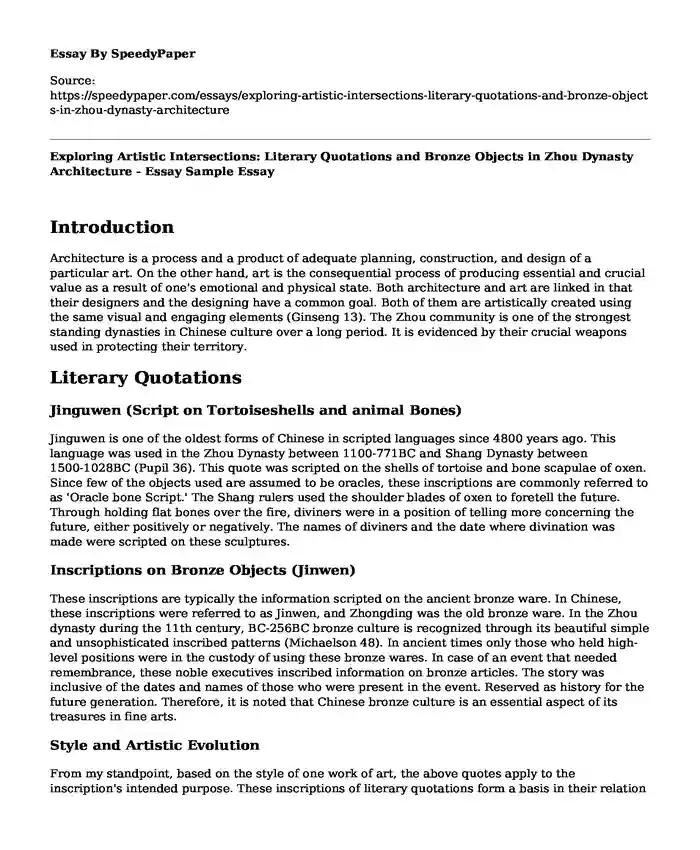
| Type of paper: | Essay |
| Categories: | History Culture Architecture |
| Pages: | 3 |
| Wordcount: | 632 words |
Introduction
Architecture is a process and a product of adequate planning, construction, and design of a particular art. On the other hand, art is the consequential process of producing essential and crucial value as a result of one's emotional and physical state. Both architecture and art are linked in that their designers and the designing have a common goal. Both of them are artistically created using the same visual and engaging elements (Ginseng 13). The Zhou community is one of the strongest standing dynasties in Chinese culture over a long period. It is evidenced by their crucial weapons used in protecting their territory.
Literary Quotations
Jinguwen (Script on Tortoiseshells and animal Bones)
Jinguwen is one of the oldest forms of Chinese in scripted languages since 4800 years ago. This language was used in the Zhou Dynasty between 1100-771BC and Shang Dynasty between 1500-1028BC (Pupil 36). This quote was scripted on the shells of tortoise and bone scapulae of oxen. Since few of the objects used are assumed to be oracles, these inscriptions are commonly referred to as 'Oracle bone Script.' The Shang rulers used the shoulder blades of oxen to foretell the future. Through holding flat bones over the fire, diviners were in a position of telling more concerning the future, either positively or negatively. The names of diviners and the date where divination was made were scripted on these sculptures.
Inscriptions on Bronze Objects (Jinwen)
These inscriptions are typically the information scripted on the ancient bronze ware. In Chinese, these inscriptions were referred to as Jinwen, and Zhongding was the old bronze ware. In the Zhou dynasty during the 11th century, BC-256BC bronze culture is recognized through its beautiful simple and unsophisticated inscribed patterns (Michaelson 48). In ancient times only those who held high-level positions were in the custody of using these bronze wares. In case of an event that needed remembrance, these noble executives inscribed information on bronze articles. The story was inclusive of the dates and names of those who were present in the event. Reserved as history for the future generation. Therefore, it is noted that Chinese bronze culture is an essential aspect of its treasures in fine arts.
Style and Artistic Evolution
From my standpoint, based on the style of one work of art, the above quotes apply to the inscription's intended purpose. These inscriptions of literary quotations form a basis in their relation to the same artist's different artworks. They both have the same archeological culture (Zakaras and Lowell 88). In the historical background, the style has been used as a significant component of art. Since World War II, this aspect has tremendously diminished in terms of its value as various artists have found different artistic styles. According to Eisner, in the whole period of the 20th century, style art has been the great disciplines of fine art, but after the seventies and eighties, it has died slowly (Schogt 33).
Conclusion
Art was inscribed in bronzeware in the Zhou Dynasty to protect their culture and remember important events. Those who held noble positions had the upper hand in accessing these bronze wares. Furthermore, the Zhou Dynasty is among the standing communities due to their supper weapons made of bronze. The art style has died down since time immemorial due to the changes made in the art industry. Therefore, Architecture and art need to go hand in hand to justify the purpose of fine art.
Works Cited
Michaelson, Carol. "Northern Zhou dynasty family." Oxford Art Online, 2018.
Pupil, François. "Troubadour style." Oxford Art Online, 2016.
Schogt, Henry G. Linguistics, literary analysis, and literary translation. Univ of Toronto Pr, 2019, p. 33.
Singson, Doug. "Popular culture and American art." Oxford Art Online, 2017.
Zakaras, Laura, and Julia Lowell. "Cultivating Demand for the Arts: Arts Learning, Arts Engagement, and State Arts Policy." 2018.
Cite this page
Exploring Artistic Intersections: Literary Quotations and Bronze Objects in Zhou Dynasty Architecture - Essay Sample. (2024, Jan 28). Retrieved from https://speedypaper.com/essays/exploring-artistic-intersections-literary-quotations-and-bronze-objects-in-zhou-dynasty-architecture
Request Removal
If you are the original author of this essay and no longer wish to have it published on the SpeedyPaper website, please click below to request its removal:
- Main Street Urban Development. Free Essay for You
- Temple of Caesar, Art Essay Sample for Students
- American Government Essay Sample
- Free Essay: How Temperature Determines Sex in Reptiles and the Consequences of This Mode of Sex
- Essay Sample: Heart Set. an Interview
- Essay Sample: The Role of the Risk Management Professional
- Pancreas On-Chip Bioengineering - Essay Sample
Popular categories




